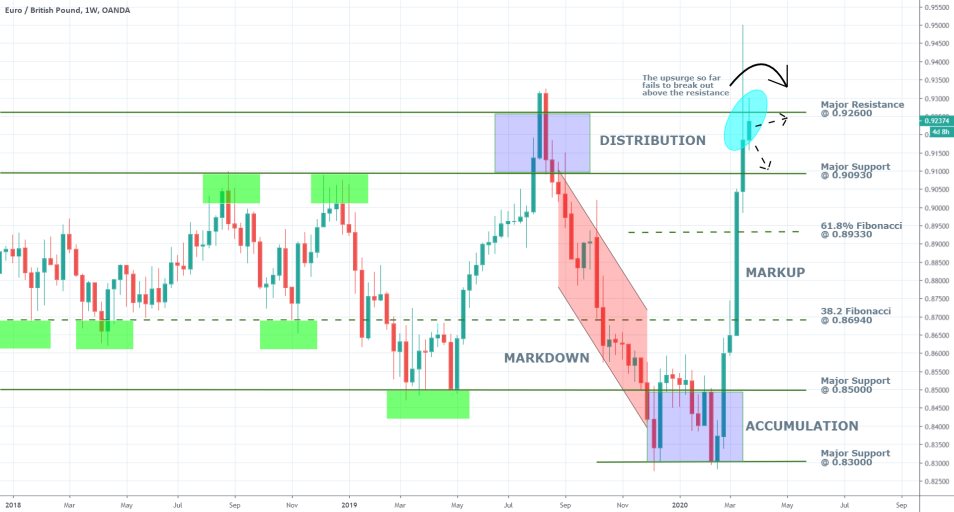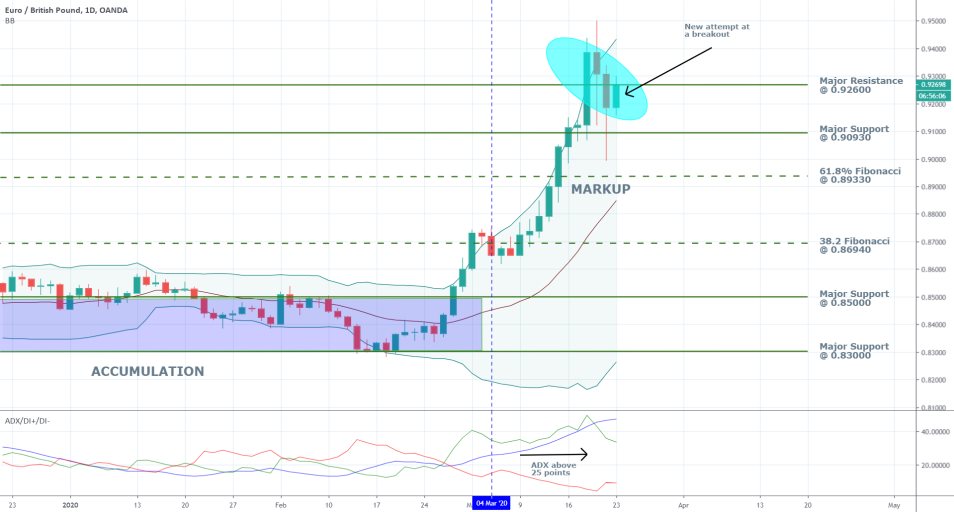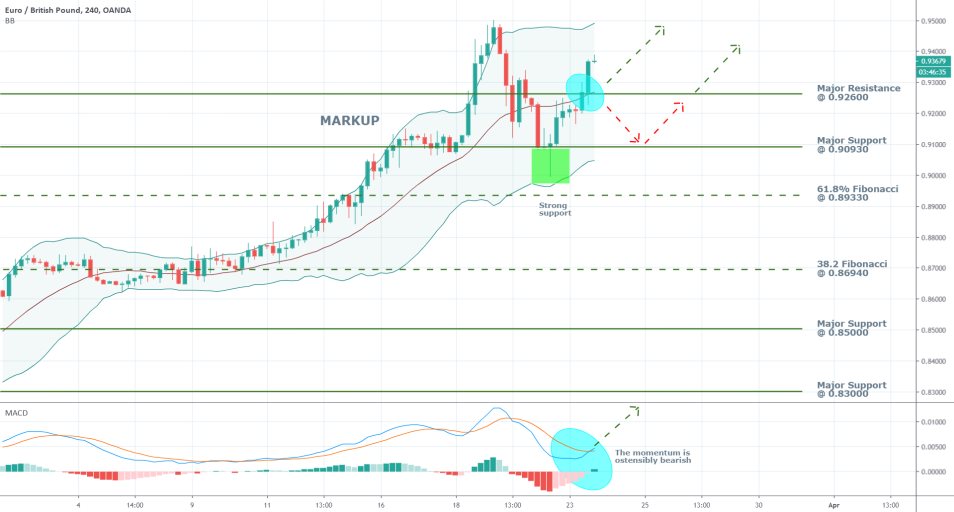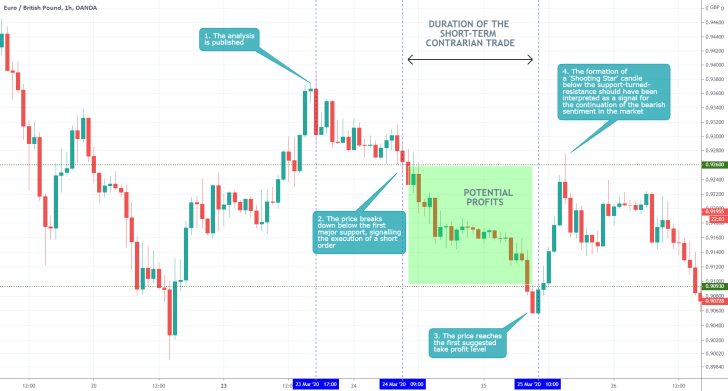A lot of crucial developments have taken place in the Eurozone and Britain over the course of last week, and there are plenty of vital economic releases that are scheduled for release over the next few days. The markets are bracing for another momentous week driven by massive volatility outbursts and substantial price swings.
Traders are currently positioning themselves in anticipation for the release of the Services and Manufacturing PMI data in the EU and in the UK, which is bound to stir the price action on the EURGBP. Those numbers are going to present the first solid evidence reflecting on the fallout from the coronavirus on the economies in the Eurozone and the UK. In that sense, the economic reports are going to provide investors and traders with the first statistical metrics, which can either affirm or disprove their earlier expectations regarding the scope of the coronavirus.
It follows that the PMI data in the EU and the UK could propel the EURGBP in either direction, depending on how far off or close to the consensus forecasts the final results turn out to be. Thereby, the purpose of the present analysis is to examine the current state of EURGBP's price action. It aims to determine whether last week's bullish trend is going to be continued, or the formation of the recent consolidation range is an early indication that the direction of the price is ready to revert itself.
1. Long Term Outlook:
As can be seen from the weekly chart below, the price action has taken a sharp U-turn over the past several weeks, as the coronavirus situation started becoming more dire globally. Prior to the outbreak of COVID-19, the price was following the structure of a classic Wyckoff cycle.
As global markets started to get spooked by the more pronounced prospects of a new global recession around mid-February, the euro started gaining strength due to higher demand for the central currency in emerging markets. This resulted in the formation of a breakout above the Accumulation range’s upper boundary, leading to the creation of a new Markup.

The Markup has subsequently broken out above the major resistance (currently support) level at 0.90930, which served as the last Distribution range's lower boundary. This means that the price action is presently threading in an area, which could end up being a potential turning point for its underlying direction. In other words, the EURGBP is currently trading in a range, which has previously served as a Distribution; thereby increasing the likelihood of a trend reversal around the current market price.
Two likely outcomes are stemming from the current market setup. The Markup could break out above the major resistance level at 0.92600, provided that the underlying fundamentals continue to support heightened demand for the euro. The massive upper shadow of last week’s candle represents uncertainty in the market.
This has become especially true following ECB’s announcement of a liquidity boost, which is a part of the central bank’s bid to accommodate the reeling economy of the Eurozone. Regardless, the bolstered asset-purchasing program of the bank would disadvantage the strength off the euro in the long run. Hence, the long upper shadow can be taken to represent an initial failed attempt of the EURGBP at breaking out above the aforementioned resistance. This, however, does not necessarily mean that the pair is headed for a turnaround.
Alternatively, the price can bounce back from the resistance and consolidate within the boundaries of the previous Distribution range. This could potentially offer contrarian traders an opportunity to enter around the bullish trend’s peak, on the anticipation for a trend reversal.
If the price starts consolidating in a new Distribution range in that area, its lower boundary is naturally going to be the major support level at 0.90930. If the price manages to break down below it at a later stage, the next logical target for such a newly established Markdown would be the 61.8 per cent Fibonacci Retracement level at 0.89330. The intermediary price level at 0.90000 should also be acknowledged because of its psychological importance, due to the four zeroes in the number. This is what makes it yet another potential turning point for the underlying direction of the price action.
2. How Are the Industries in the EU and the UK Faring During the Pandemic?
In our weekly expectations update from today (link above), we have outlined how the market is bracing for the PMI data releases in Germany and France, which are scheduled for tomorrow. These include numbers in manufacturing and services. Similar data for the British industry is also scheduled for release tomorrow.
Naturally, if any of the recorded data exceeds the consensus forecasts, this would be good for the underlying currency. If the findings of the reports, instead, are inlined or fell short of these preliminary expectations, this would be bad for the underlying currency. Therefore, traders are advised to watch for the PMI Services and Manufacturing data in France, Germany and the UK as it starts pouring in tomorrow in the same order.
Additionally, the Bank of England is scheduled to hold another monetary policy meeting on Thursday, which comes after Boris Johnson’s comments over the weekend. It seems that the UK is moving on a path towards fully embracing the social distancing strategy of battling the COVID19 outbreak, which would have profound consequences on the British economy.
It is currently quite vulnerable to external pressures due to the no-deal Brexit, which means that the British economy as a whole is much less competitive, and would struggle greatly to survive on its own while British workers remain isolated at home. All of this is likely to prompt a weakening of the pound over the next following weeks.
Meanwhile, there is one additional external factor that is worth our consideration. Prior to the US market open today, the FED surprisingly announced its readiness to buy ‘unlimited’ amounts of treasury bonds and other mortgage-related securities in a bid to keep the borrowing costs in the States flat at zero-costs. It means that the scope of its quantitative easing program is now entering uncharted territory, and the sheer size of the money supply circulating in the economy is going to rise exponentially.
The massive levels of liquidity are going to devalue the greenback and strain the demand for the dollar even within emerging markets over the following months. Investors and traders are going to start weighing in the resilience of the dollar in light of the substantially bolstered liquidity, which could prompt a lot of them to move to the next-best-thing, which is the euro.
Even though the Eurozone is also currently being supported by ECB’s own asset-purchasing program, which is quite robust as well, for the time being, the centralised currency is not being put under the same constraints and pressure as the dollar. This is another factor, which is likely to support the continuation of the bullish trend on the EURGBP in the midterm.
3. Short Term Outlook:
As can be seen on the daily chart below, the underlying bullish trend had become substantially strong on the 4th of March, when the ADX moved past the 25 points mark.
Such trending environments are seldom terminated by sharp reversals in the direction of the underlying price, which at present seems even more unlikely given the prevailing conditions on the market. Hence, the continuation of the bullish trend's establishment seems like the most likely outcome; however, a short-term pullback could also form around the major resistance at 0.92600.

The green rectangle on the 4H chart below illustrates the strong support around the 0.90930 price level. This is yet another confirmation of the robust bullish sentiment in the market. At present, the price action is attempting another break out north above the major resistance level at 0.92600.

Additionally, the MACD currently finds itself at the early stages in the formation of a potential bullish crossover, which would illustrate the termination of the underlying bearish momentum. Such behaviour would favour the continuation of the prevailing bullish trend’s development.
4. Concluding Remarks:
The underlying fundamentals continue to be congruent with the anticipations for the continuation of the current bullish trend. The long term fundamentals are prevailingly bullish, and the bullish sentiment seems to be strengthening as the euro continues to be on the path of becoming the next most desired liquid asset under the COVDI19 pandemic.
Meanwhile, Boris Johnson’s comments over the weekend underscore the now increased chance of a national lockdown in Britain, which, in turn, would put additional pressure on the already struggling pound.
Nevertheless, the EURGBP pair also can consolidate in the short run within the boundaries of the previous Distribution range, as illustrated on the weekly chart above.

- The longer-term expectations of the analysis for the continuation of the bullish trend were not realised. Because of this failed reading of the underlying fundamentals, when the market signalled the execution of a short contrarian trade, it was terminated prematurely resulting in a lot of missed opportunities.
Disclaimer: Your capital is at risk! Trading and investing on the financial markets carries a significant risk of loss. Each material, shown on this website, is provided for educational purposes only. A perfect, 100% accurate method of analysis does not exist. If you make a decision to trade or invest, based on the information from this website, you will be doing it at your own risk. Under no circumstances is Trendsharks responsible for any capital losses or damages you might suffer, while using the company’s products and services. For more information read our Terms & Conditions and Risk Disclaimer.





















